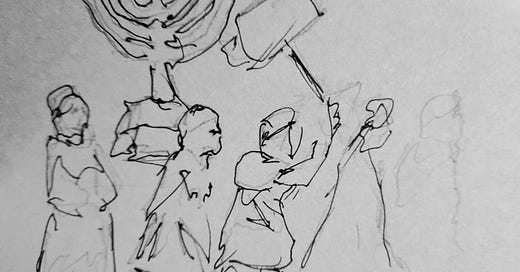When communities gathered around this ritual meal, this visceral re-membering with a messiah figure who had “emptied himself… become as a slave” and died the slave’s death, the slave's experience was at the heart of the ceremony. But not only the slave's experience. A second community was also held at the heart of the table.
It is told that the child Jesus was taken to Egypt to escape the violent whims of Herod the Great. Herod had been sat on that throne a long time. He was installed by the Roman colonisers and did a good job of keeping the Jewish nation orderly for Caesar. Naturally, he was not loved by his own people. Having become the classical archetype of the damned tyrant — a spitting cauldron of anxious power — Herod was spooked by rumours of a messianic birth. Finding themselves under his murderous glare, Jesus’ family spent a while in Egypt, waiting for the puppet king to die.
Others were waiting also. After Herod’s death there was an insurrection led by a certain Judas Ben Hezekias. With a small army of rebels he tried to interrupt the moment of succession and break the grip of Rome’s puppet rulers. The rebellion was not successful. They were crushed by the Roman general Varus, who then schooled the natives by way of a mass crucifixion of about two thousand Jews, according to Josephus.
The young messiah figure returned to a homeland haunted by horror and brutality, where scores of relatives had helplessly watched their loved ones dying, nailed to trunks, over days, under Roman military occupation.
If crucifixion was known as the Slave’s Punishment it also belonged to a second underclass. It was commonly the death of the colonised also. Judas Ben Hezekias' insurrection was one moment in a long history of resistance which led to the Jewish war of 66—70 CE. In the end, Jerusalem was sacked by the Romans who waited outside for the population to die of plague and famine. Desperate residents were caught making trips outside the walls looking for food. All were tortured and crucified. Five hundred or more each day, says Josephus.
“The soldiers themselves through rage and bitterness nailed up their victims in various attitudes as a grim joke, till owing to the vast numbers there was no room for the crosses and no crosses for the bodies.”
He concludes that Titus allowed this hellish spectacle across the Judean hills in order to persuade the city to surrender. Crucifixion was a public relations activity.
There was a calculated power-relation between the practice of crucifixion and the land itself. The killing of natives by nailing them to trees and stakes, to expire slowly and be eaten by birds and rats, was a way of marking territory. A crucifixion was a temporary monument. It was a way of inscribing law and rule into the land itself: a stamp of Caesar's ownership. When the slave rebellion of Spartacus was defeated, about six thousand were crucified at intervals along a hundred miles of road from Rome to Capua. When Titus sacked Jerusalem the land surrounding the city was shorn of trees to a ten mile radius, felled to build siege towers and thousands of crosses. The whole landscape, says Josephus, became an unrecognisable waste.
The death of the messiah figure was one of countless such executions that occurred between the mass crucifixion events of 4 BCE and 70 CE. Jerusalem was a colony on the edge. As Luke retells it, Jesus understands his own walk to the stake in continuity and solidarity with all who would meet the same imperial violence: “Do not weep for me, but weep for yourselves and for your children… For if they do this when the wood is green, what will happen when it is dry?”
As with slaves across the empire, crucifixion hung over colonised lives also and spoke of their exteriority from power and rule. Rebels were executed by roads outside the cities; on margins, outside the circle of citizenship; on the land outside the decency of civilisation. After Jerusalem fell, with catastrophic numbers dead, nearly a hundred thousand survivors would be sold as slaves, scattered across the empire. The enslaved and the colonised shared a common experience of subjection, that was written in brutality across the land itself.
There is a famous carving sculpted into the Arch of Titus in Rome, built in 81CE. It depicts Caesar's triumphal procession after the sack of Jerusalem. The Roman soldiers are making a public spectacle of their enemies, carrying menoras and other sacred objects from the burning temple to the city of Rome. This was the usual dance, celebrating the law of empire written anew across colonised lands. But hear, once again, the perplexing language of reversal round the table of those outsiders. They are breaking bread and drinking wine together, remembering the crucifixion of a colonised peasant messiah, who,
“...erases the decrees written against us, taking them aside and nailing them to the cross. Having disarmed the rulers and the masters, he made a public spectacle of them, triumphing over them.”
Here is the mysterious transferral once again, in which the subjected walk across the room and take ownership of the threat that has long hung over them. And when they do, something strange and disturbing has occurred. It is they who gather outside the walls. It is they who have become the threat. Meanwhile law, debt and mastery are nailed in mockery to their own executionary stake.




A perfect, if unsettling, post for Ash Wednesday. Thank you for telling this story so clearly, and for leaving so many threads dangling.